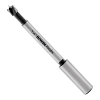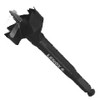Wood Drill Bits
Wood drill bits are specialized tools used for drilling holes in wood. They are designed to efficiently cut through wood fibers and create clean, precise holes. Wood drill bits typically have a pointed tip for easy starting and a fluted shaft with spiral grooves that help remove wood chips during drilling. The flutes also help in guiding the bit through the wood, preventing overheating and binding.
Wood drill bits come in various sizes, ranging from small diameters for pilot holes to larger diameters for larger openings. They are commonly available in fractional inch sizes (e.g., 1/8", 1/4", 1/2") and metric sizes (e.g., 3mm, 6mm, 12mm). The shank of the drill bit is often round and designed to fit into a drill chuck securely.
There are different types of wood drill bits, each suitable for specific drilling tasks:
-
Twist Drill Bits: These are the most common type of wood drill bits. They have a sharp, twisted cutting edge that helps in drilling through wood quickly.
-
Brad Point Bits: These bits have a pointed tip with spurs on the sides. The spurs create clean entry holes and help maintain accuracy. Brad point bits are commonly used for dowel holes and other precision drilling applications.
-
Forstner Bits: Forstner bits are ideal for drilling flat-bottomed holes, overlapping holes, or holes with a larger diameter than the shank. They have a central point and flat cutting edges that shear through wood, leaving a clean, precise hole.
-
Auger Bits: Auger bits have a screw-like design with a wide, flat cutting edge. They are commonly used for drilling deep holes in wood, such as for large dowels or holes for plumbing and electrical work.
-
Spade Bits: Also known as paddle bits, spade bits have a flat, wide cutting surface shaped like a paddle. They are often used for drilling large-diameter holes in wood, such as for installing door locks or running cables.
When using wood drill bits, it's important to select the right size for the desired hole and to use appropriate drilling techniques to avoid splintering or damaging the wood.






